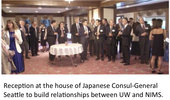Highlight
International Workshop on Nanotechnology
Achievement/Results
The University of Washington Center for Nanotechnology (UW-CNT) and Japan’s National Institute for Materials Science (NIMS) co-sponsored an International Workshop on Nanotechnology in conjunction with a special UW-NIMS Forum on Molecular Architectonics, June 10-12, 2009. Over 250 people registered for this workshop. The joint workshop was an outgrowth of the UW-NIMS Joint Graduate Program established in 2008 promoting the exchange of students between the two institutions, as well as a continuation of a series of UW-CNT sponsored workshops aimed at increasing awareness of nanotechnology research and applications both amongst different groups on campus and between UW and the general community.
NIMS, located in Tsukuba Science City, Japan, is Japan’s only administratively independent institution specializing in materials science. As a hub for Japan’s most advanced experimental facilities, NIMS is a perfect partner for our students to be exposed to state-of-the-art instrumentation and to collaborate with first class scientists in their disciplines. In April 2008, NIMS established an Overseas Operations Office (O3) on the UW campus with support from their International Center for Materials Nanoarchitectonics (MANA), which in turn led to creation of the UW-NIMS Joint Graduate Program, where NIMS can financially support graduate students from UW to perform research at NIMS. Through this program, we hope students will tap into a creative international experience, enriching their education by establishing productive, mutually-beneficial relationships between the UW and Japanese science and engineering communities.
The three-day workshop included half-day sessions on applications of nanotechnology to energy, electronics and medicine, followed by two additional half-day sessions on molecular architectonics aimed at laying the groundwork for future collaborations between the incipient Molecular Engineering program at UW (an outgrowth of the Center for Nanotechnology, for which a new building is under construction) and the NIMS International Center for Materials Nanoarchitectonics (MANA). In addition to 9 NIMS staff scientists and 15 UW faculty (from 7 different departments), there were 7 external invited speakers from industry, national laboratories and academia. The invited talks focused on overviews, rather than detailed reports on single experiments, with a goal of introducing the attendees to potential areas of interaction and study. More specific results were highlighted in the poster session, combined with five-minute oral presentations by graduate students (including several IGERT trainees) at the end of each invited session to introduce key posters. Over 200 people attended the workshop, and 32 students presented posters. The best student poster received an award (travel to another meeting). The Japanese Consul General hosted a reception in connection with the workshop (see image) to further enhance interactions between UW and NIMS. In addition to speakers at the meeting, the reception also included representatives of the local Japanese business community, members of both NIMS and UW administration, and the student organizing committee.
Address Goals
Graduate student trainees from the National Science Foundation Integrated Graduate Education and Research Training (NSF-IGERT) program in Nanotechnology formed the organizing committee for the UW-NIMS workshop, under the guidance of IGERT principal investigator (PI) Marjorie Olmstead, and two of her co-PIs, Fumio Ohuchi and Francois Baneyx. Trainees chose the topics for the meeting, chose and invited both internal and external speakers, and hosted a luncheon for the outside speakers during the meeting. In the process, they learned many elements of conference organization, including balancing elements in the scientific program, planning a program that optimizes networking opportunities, reaching compromise amongst themselves, collecting information on potential speakers, inviting speakers, both local and external, and then dealing with acceptance and rejection of their invitations, and the essentials of meeting logistics. They also formed important networking bonds with major players in their fields. In addition to selecting outside speakers, the student organizing committee also selected the UW faculty to speak at the workshop, taking both presentation style and topic into account. Overall, the experience of having trainees lead the workshop organization was both an excellent educational tool for the students and a way to ensure excellence and coherence in the presentations at the workshop.
One invited speaker, Byron Gates, was a former UW-CNT IGERT trainee who now holds a Canada Research Chair in Surface Science at Simon Frasier University. He spoke on self-assembled nanostructures for photothermally activated processes. Another invited speaker was Gates’ “academic grandfather,” George Whitesides of Harvard, who spoke on new developments in inexpensive medical diagnostics for the developing world. This juxtaposition was a powerful example for student attendees showing both continuity and the wide range of possibilities that can arise from a common interdisciplinary training in nanoscale interactions. Many students commented on the benefits of meeting a successful IGERT alumnus.
The meeting proved highly successful in its goal of promoting interactions between UW and NIMS. Subsequent to the workshop, UW and NIMS submitted a joint proposal on Molecular Architectonics to the NSF to build on interactions solidified at this workshop. Scientists on both sides of the Pacific came up with new ideas building on complementary expertise explored at the workshop. Several UW faculty members have since traveled to NIMS to follow up on potential collaborations, and one former IGERT trainee spent a month in Japan performing experiments with NIMS collaborators, as did IGERT co-PI Fumio Ohuchi.






